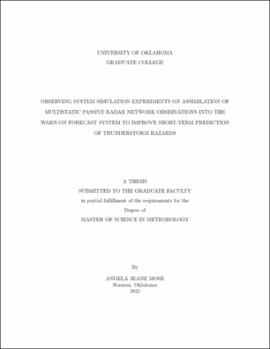| dc.contributor.advisor | Skinner, Patrick | |
| dc.contributor.author | Mose, Angela | |
| dc.date.accessioned | 2022-12-08T15:48:59Z | |
| dc.date.available | 2022-12-08T15:48:59Z | |
| dc.date.issued | 2022-12-16 | |
| dc.identifier.uri | https://hdl.handle.net/11244/336884 | |
| dc.description.abstract | The Warn-on-Forecast System (WoFS) assimilates radar and satellite observations to produce initial conditions for short-term forecasts of individual convective storms. The accuracy of the WoFS analysis is a function of the quality and number of observations assimilated. For example, Doppler radar velocity data provide useful information on the observed wind field; however, it only provides velocity observations radial to the radar beam. Recently a network of low-cost multistatic, passive radar receivers have been developed for use with the WSR-88D network. The passive radar network allows for sampling of bistatic velocities across a wide region and provides a more accurate depiction of the three-dimensional wind field in and around thunderstorms as they initiate, mature, and dissipate. Assimilation of multistatic, passive radar network observations into WoFS has the potential to improve storm-scale analyses and short-term forecasts.
This study uses Observing System Simulation Experiments (OSSEs) to assess the implications of assimilating multistatic network observations into WoFS. An OSSE was designed for a non-tornadic, hail-producing supercell that impacted northern Texas on 7 May 2020. A truth run is generated by downscaling a single real-time WoFS member forecast to 250-m horizontal grid spacing. Multistatic network observations, using six passive receivers and an emulated WSR-88D, are then created from the truth run and assimilated into the remaining WoFS members to assess the impact of these observations on the quality of WoFS analyses and forecasts of the supercell, particularly early in the storm’s life cycle. The multistatic network and the WSR-88D simulations are compared to the truth run via subjective comparisons and statistical methods. Preliminary analyses reveal minimal differences in forecast quality between the Multistatic experiment and the WSR-88D experiment; however, statistical results suggest that the WSR-88D simulation produces a slightly better forecast with higher correlation to the truth run. | en_US |
| dc.language | en_US | en_US |
| dc.subject | Warn-On Forecast | en_US |
| dc.subject | OSSE | en_US |
| dc.subject | Multistatic network | en_US |
| dc.title | Observing System Simulation Experiments on Assimilation of Multistatic Passive Radar Network Observations into the Warn-On Forecast System to Improve Short-Term Prediction of Thunderstorm Hazards | en_US |
| dc.contributor.committeeMember | Palmer, Bob | |
| dc.contributor.committeeMember | Bodine, David | |
| dc.contributor.committeeMember | Wang, Xuguang | |
| dc.date.manuscript | 2022-12-06 | |
| dc.thesis.degree | Master of Science in Meteorology | en_US |
| ou.group | College of Atmospheric and Geographic Sciences::School of Meteorology | en_US |
